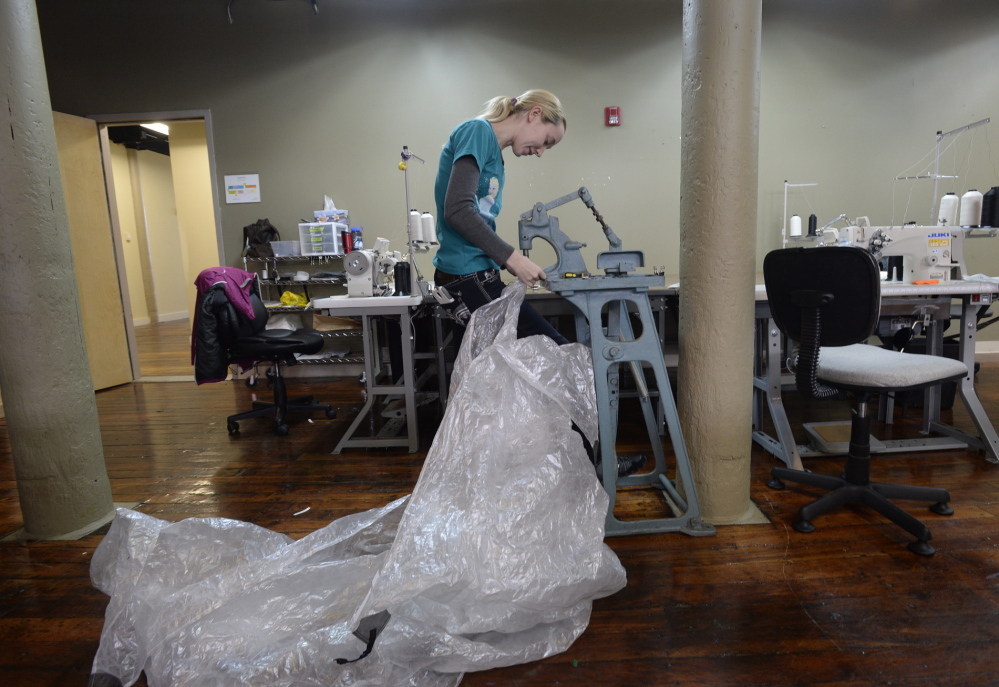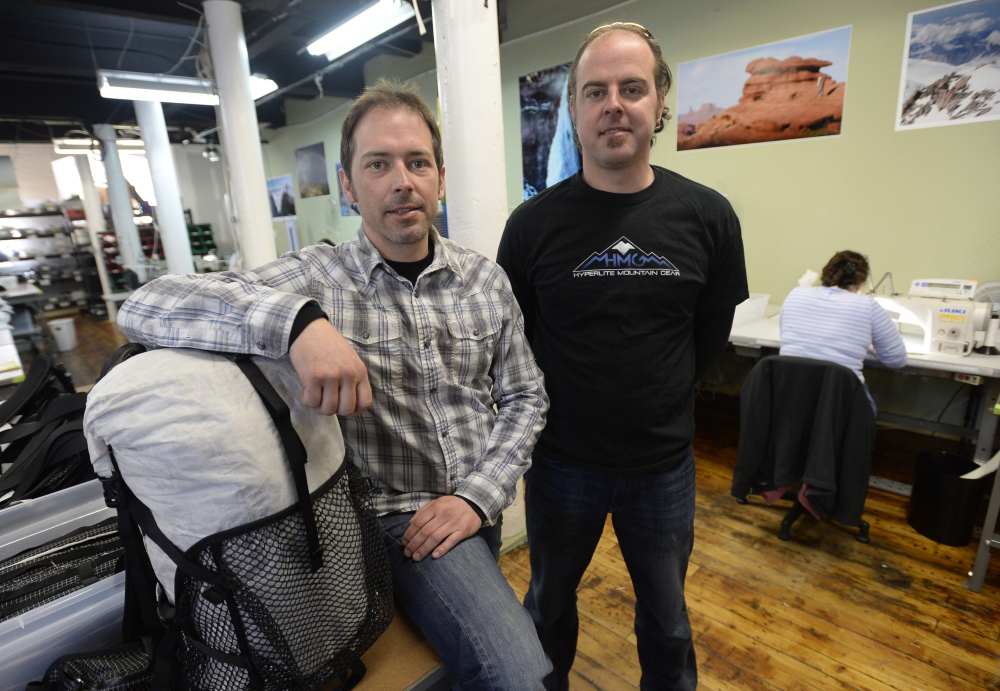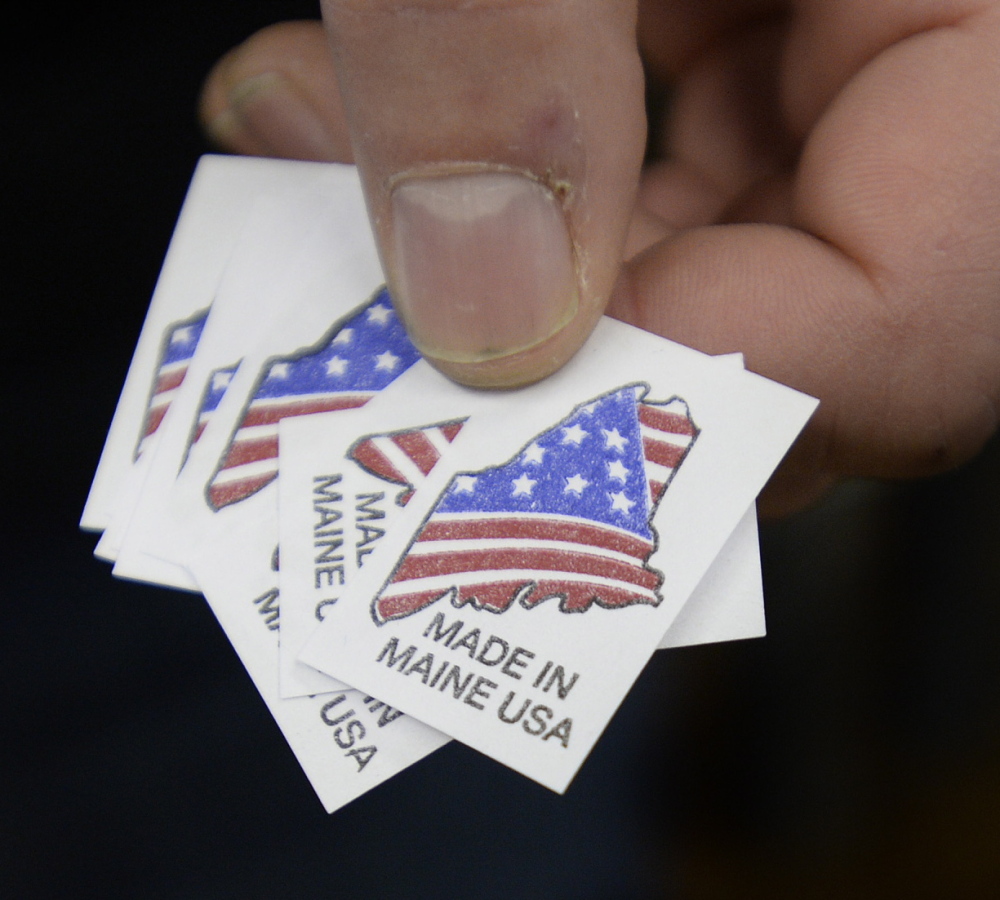While Hyperlite Mountain Gear specializes in ultra-lightweight outdoor equipment, the Biddeford company itself is about to add some bulk.
Hyperlite, which makes pared-down backpacks and shelters for the hardiest outdoor adventurers, is poised to double its manufacturing space in the Biddeford mills and add 25 to 30 jobs over the next two and a half years to its existing staff of 13 people.
As it grows, Hyperlite aims to follow its “keep it simple” philosophy and not follow in the footsteps of the large outdoor equipment retailers it sees as too caught up with marketing rather than functionality, said Hyperlite founder, chief executive and designer Mike St. Pierre.
“The larger companies are a lot slower to move. They’re dinosaurs. They’re using the words like ‘lightweight’ and ‘ultra-lightweight’ but not really doing it,” St. Pierre said. “Any core piece of gear in the industry can benefit from our philosophy. We want to take the most modern materials and the most minimalist designs to make the best lightweight outdoor equipment available.”
Hyperlite started as an idea in 2008 when St. Pierre, then a chef in New York City, was trying to lighten his load while on hiking trips in the Adirondacks.
“I was always looking for ways to reduce my gear weight. Everything was overbuilt and too heavy. It slowed me down,” St. Pierre said. “The big companies are always building stuff with too many bells and whistles.”
He got his hands on Cuben fiber, a high-performance, composite laminate developed in the 1990s by a nuclear weapons physicist and an aerospace composite engineer. The material, originally designed for use in sailing, is 50 to 70 percent lighter and four times stronger than Kevlar. It also floats on water, is highly chemical-resistant, UV-resistant and 100 percent waterproof. The material is strongest in white since dyes would compromise the fibers, so Hyperlite’s bright white equipment stands out in the woods.
St. Pierre began making his own prototypes of backpacks and tarps in 2009 and tested them out on trails. At the start of a three-day trip into the Adirondacks, a ranger stopped him to check if he had the right equipment to survive a lengthy trip since he was carrying such minimal equipment.
In the past, hikers and backpackers traditionally carried packs that comprised one-third of their body weight. Now, hikers with ultra-light gear can carry a full pack, including food and water, of 20-25 pounds. That allows them to be more comfortable, use less food, go further into the trail and cover more ground in a day, St. Pierre said.
St. Pierre relocated to Maine, borrowed every sewing machine in his family and recruited his brother Dan, who had corporate experience with companies such as Moody’s Investor’s Service and Bristol-Myers Squibb, to be his partner and the company’s chief financial officer.
Over time, Hyperlite moved out of its garage manufacturing site and into a small space in the mills at Biddeford, where it now has commercial-grade sewing equipment.
“Part of the move to Biddeford was to find some experienced stitchers here. We found some great sewers in Biddeford and they are our teachers for the next generation,” Dan St. Pierre said. “Maine has a great reputation for hard work and a little grittiness.”
Hyperlite, which had some seed funding from family and friends and later nabbed a grant through the Maine Technology Institute’s TechStart program, now is trying to finalize funding that will allow it to expand into its larger, 7,500-square-foot space in Biddeford, strengthen its research and development efforts, create a marketing department and bolster its branding and marketing efforts.
The company declined to disclose how much it was seeking in this current round of investment.
Hyperlite said it has fewer than 10,000 customers a year, but declined to comment on its sales figures or average customer purchase. Its Windrider pack, which sells for $275 to $345 depending on the model, is its best-selling product and weighs 28.2 ounces.
“Hyperlite’s success is very important. Their expansion has been a long time coming. The demand for their product is growing so fast,” said Biddeford Mayor Alan Casavant. “With their stitching capabilities, the city’s come full-circle. We’ve got this modern, vibrant company using the skills and heritage of the past. The building themselves are being revitalized. Our ancestors worked in these mills before they fell on hard times. Here we are in 2014 with new vibrancy and a new sense of energy.”
Hyperlite currently offers 16 packs, several shelter systems and tarps, and various accessories, including stuff sacks and trail totes – all of which have been used on every continent. To expand the company, Hyperlite wants to broaden its product line to other, hybrid outdoor activities such as bike-packing and ski touring and pack-rafting.
“By keeping all systems as simple as possible, and keeping the gear as light as possible, users can tackle multiple disciplines,” St. Pierre said.
Max Neale, a senior editor who tests outdoor equipment for OutdoorGearLab, said he personally uses almost every Hyperlite product available.
“The thing that sets Hyperlite products apart is that they need to be really light and make sure they’re durable. If you’re doing really hard, outdoor activities and pushing equipment to the limit, you want to have confidence in it,” Neale said. “They’re at the cutting edge of the industry. It’s really surprising to me that they’re in Maine because the bulk of the outdoor industry is based in the western U.S. Their ability to create these products without being surrounded by the buzz of the industry is really surprising.”
Daniel Stevenson, Biddeford’s economic development director, sees Hyperlite’s and St. Pierre’s presence in Biddeford as important for the town.
“He’s a true entrepreneur. He tackles things, figures things out, creates great business models and grows a company. Having homegrown manufacturing right in Biddeford is quite fantastic. They are a model for manufacturing and continue to grow employment all while creating a world-class product,” Stevenson said.
Hyperlite has received notice from publications ranging from Backpacker, Climbing, and Outside to even GQ and Wired.
Its customers, who buy the product through the company’s website, are passionate users who put them to the test hiking the 2,181-mile Appalachian Trail, the 2,663-mile Pacific Crest Trail or even Mount Everest.
For example, when camera operator John Griber summits Everest in May to film “Everest Jump Live” – a live jump off the world’s tallest peak by a man in a wingsuit – he expects to worry about getting the perfect angle for the live broadcast, but he won’t be worried about his equipment. He’s planning to carry one of Hyperlite’s packs, which will shave several crucial pounds off his load, he said.
“These guys have taken functionality and performance to the edge. Why wouldn’t you want to try to get the strongest, best, lightest equipment available?” said Griber. “Their equipment has everything you need in the simplest possible form. The packs are built for real, true outdoor adventurers. Plus, a white pack is pretty bad-ass.”
Griber has summited Everest twice before, using other, heavier equipment.
“I was always carrying a heavier pack. This is going to be a big difference. It’s great to be shaving off not just a few ounces, but a few pounds. It’s a no-brainer,” Griber said.
Jessica Hall can be contacted at 791-6316 or at:
jhall@pressherald.com
Twitter: @JessicaHallPPH
Copy the Story Link
Send questions/comments to the editors.





Success. Please wait for the page to reload. If the page does not reload within 5 seconds, please refresh the page.
Enter your email and password to access comments.
Hi, to comment on stories you must . This profile is in addition to your subscription and website login.
Already have a commenting profile? .
Invalid username/password.
Please check your email to confirm and complete your registration.
Only subscribers are eligible to post comments. Please subscribe or login first for digital access. Here’s why.
Use the form below to reset your password. When you've submitted your account email, we will send an email with a reset code.